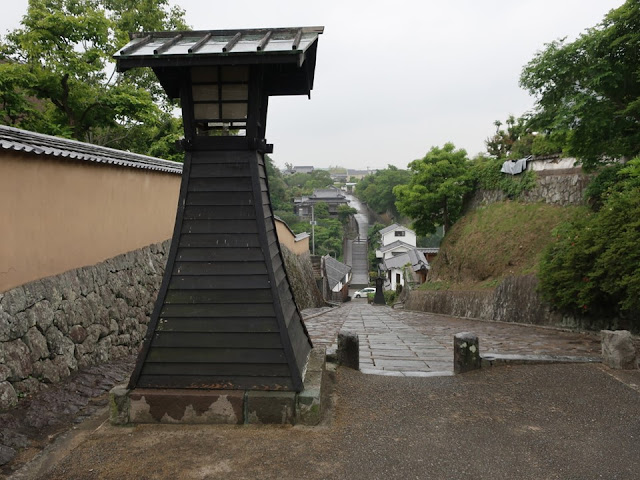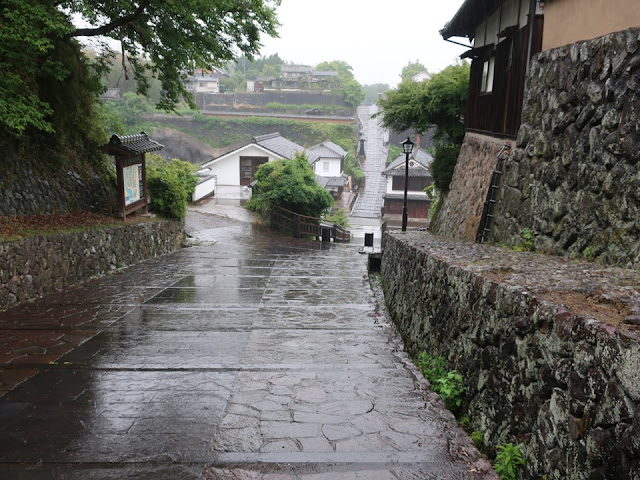The structure of Kitsuki in Oita Prefecture (southern Japan) is very special. There are two plateaus in the town in which there were samurai’s residences and there are also temples. Merchants have lived between two plateaus. Old houses remain and the area is designated as “Preservation Districts for Groups of Traditional Buildings” by the government. The photo above is a view of the southern plateau from the northern one across the merchant area.
別府と大分空港の間にある杵築は、二つの台地の上が武家屋敷と寺町、その間の低地が商人町という独特な地形の城下町(譜代・松平氏3万2千石)です。古い家々が残り、重要伝統的建造物群保存地区に指定されています。上の写真は北の台地から商人町の谷を経て、南の台地を見たものです。
There is Kitsuki Castle at the end of the northern plateau. Residences of high-class samurai remain there. There was also Kitsuki-han (local government) school, which is a site of an elementary school now. I imagined that samurai boys who went to school appeared.
北の台地は杵築城につながり、上級武士の屋敷が残っています。小路の先には藩校がありました(現在は杵築小学校)。藩校に通う武士の子たちが出てきそうですね。
The photo above shows the northern plateau and the merchant area. The view of the old town in a raining day is classy.
坂を下って南台に登り、少し上ったところから見下ろした商人町と北台です。雨の日も絵になりますねえ。
The museum is in a samurai residence area of the southern plateau.
南台の武家屋敷を入ったところに資料館があります。
There is an observation space in the museum area. It’s a calm castle town; the castle tower was rebuilt in 1970.
資料館の先には、1970年に再建された杵築城を望める展望台があります。静かな城下町です。
Kitsuki castle town museum、きつき城下町資料館
The decollated cart stations at the hall of the museum. It was made in 1933 and parades at the Tenjin Festival even until now; the festival has a three hundred years history. The name is “Gosho-Guruma”.
資料館のホールには御所車が置かれています。300年続く天神祭の練り物の一つで、展示品は1933年に作られた現役の車です。
The towners have executed the festival. It is written, “The towners have acquired education and culture, they also have taken in the samurai culture, then they have matured the culture of Kitsuki.”
Haikai poetry, tea ceremony, flower arrangement, performances (Joururi
songs, Kyougen play, Shamisen guitar, Kouta songs) and so
on have spread. The Tenjin Festival which bases on the culture is held as the
splendid towners’ festival; the Gosho-Guruma is their pride.
祭りを支えた町人たちは、「学問と教養を身につけ、武士の文化とも融合して、城下町杵築の文化を高めていきました」と書かれています。
俳諧、茶道、華道(豊後宏道流の本場)、浄瑠璃、狂言、三味線、小唄などが広がりました。そして、天神祭は、町方の祭りとして今も華やかに続けられています。御所車は、街の人々の誇りですね。
The model (1/300) shows the castle town in the end of the Edo period (1603~1868) when samurai ruled Japan. There are temples in the southern plateau, so it’s a cultural center back then, I guess.
幕末の城下町を復元した1/300のジオラマが展示されています。南台には寺院区もあり文化の中心だったと思います。
Exhibition room in the 2nd floor、二階展示室
I took photos of exhibits on the 2nd and the 3rd floors under the approval of the curator. The exhibition in the 2nd floor mainly shows the society of samurai.
ここからは、学芸員さんから、館蔵品と全景は撮影可能との許可を得て撮影しました。二階は武家を中心とした展示です。
The daimyo lord of Kitsuki went to Edo (old name of Tokyo) every other year (Sankin-koutai). He usually got on the ship and went to Osaka; it took ten days. Then, he got on a palanquin and went to Edo; it took eleven days. The length of the lord’s ship is assumed around 30 meters because the Shogunate (Bakuhu) limited the size. In the case that the lord got sea sick easily, he went to Edo by land; it took around a month.
杵築城主の参勤交代は、海路で大阪へ行き(10日間の行程)、そこから陸路で江戸へ行きました(11日間)。幕府の規制があり、御座船は全長30mぐらいと推測されています。悪天候や藩主が船酔いがちな場合は、海路を使わず、一ヶ月かけて江戸へ行ったそうです。
Work logs of the town office are preserved, which covers from 1702 to 1871. Those are precious documents to understand towners lives. I’m sure those are interesting records.
1702年から1871年までの町役所日記が残っています。町人の暮らしを知る上で貴重な資料、読みたいですね。肖像画は、測量に来た伊能忠敬さんです。
1789年の幕府巡見使への報告では、杵築藩の武士は670人(足軽、中間を含む)でした。武士は、日々の政務と学問、武術の鍛錬、神仏の行事(1~6回/月)で、「ひじょうに忙しい日々を過ごしていたようです」と書かれています。私のイメージと違いました。自己研鑽に励む藩の武士は、忙しかったのですね。
Exhibition room in the 2nd floor、三階展示室
Towners lives are introduced in this floor.
人々の暮らしが紹介されています。
“Shittoui”, which cover the surface of a tatami mat, are explained in detail. Those are special products of Kitsuki. However, the quantity of production has decreased dramatically since 1970’s, because of the lifestyle change from Japanese style to Western one. I like laying down on a tatami mat floor so much, however I have only one tatami room in my house. Because we usually sit on a chair not on a floor, moreover, a tatami floor is more expensive than a wooden one.
畳表に使用される七島藺(しっとうい)の製造について詳しく説明されています。生活様式が変化し、昭和40年代以降は、生産が激減しています。私は新しい畳の匂いがとても好きですが、我が家の和室は一間だけ。畳は贅沢品になっていますね。
The Kunugi oak forests surround 343 reservoirs in Kitsuki. The lumbers become shitake mushroom logs. The nutrients of the forests flow into reservoirs, and irrigate towards the rice fields and shittoui plants; they help plants grow. People have controlled the nature very well. It is designated “Globally Important Agricultural Heritage Systems” by Japan government.
杵築のクヌギ林が「日本の世界農業遺産」(農水省)に選ばれています。343もあるため池の周辺に植えられたクヌギは椎茸栽培の原木に使用されます。そして、林の栄養分がため池に流れ、水田に供給され、米づくりや七島藺に生かされます。人の手を加えて、上手く自然を利用していますね。
There is a section called “Ohama-shu no Hokori”, or literally, the pride of residents near beach. Fishermen in Katanoura were called “Ohama-shu”. They caught fishes for the daimyo lord, they got on a lord’s ship as sailormen; they worked for the lord. They were granted perks such as catching fishes in various places. Fishing and sailing equipment are exhibited.
「お浜衆の誇り」というコーナーです。片野浦(納屋)の漁師は、藩主用の魚を捕ったり、参勤交代の水夫を務めたりするなど藩のために働きました。彼らは「お浜衆」と呼ばれ、広域の漁業権などいろいろな特権を与えられました。海の道具が展示されています。
Plays and Kabuki in Kitsuki、杵築芝居・杵築歌舞伎
In the Edo period (1603~1868), there was a theater group in Kitsuki. They played puppet shows and Kabuki across Japan. The following Meiji period (1868-1912) was their prime times. There were three Kabuki groups and they played even in Korea and China. However, it declined because of the diversification of entertainment. Almost only stage costumes remain now.
江戸時代、杵築芝居と呼ばれた座は、諸国で人形芝居や歌舞伎を演じていました。明治時代には全盛となり、歌舞伎が三座でき朝鮮・中国へも巡業したそうです。しかし、娯楽の多様化で、今では、ほぼ歌舞伎衣装を残すのみになりました。
The photo above is a curtain of Harimaya theater group. The last shamisen player (the late Ms. Taka) maintained and preserved around four hundred costumes, and donated to the city in 1972. It is written, the flower of the people's performing arts flourished here.
400点もの衣装を毎年虫干しして保存したのは播磨屋座の最後の三味線弾きのタカさん(故人)でした。1972年に市に寄贈されました。「この地に花開いた民衆芸能の華」と書かれています。
It began to rain in earnest, but it’s a fine scenery. Kitsuki is a popular tourist destination.
本降りになってきました。雨の景色もいいですね。杵築は、観光の町としても人気です。
I had a daily set meal as a lunch. It included “ryukyu” which is a specialty in Oita. Pieces of sashimi raw fishes were soaked in soy sauce based seasoning. The fresh fishes in Oita made the dish delicious.
昼食はおまかせ定食をいただきました。「りゅうきゅう」は、刺身を、醤油やごまなどでつくるタレで和えていただく、大分県の郷土料理です。お茶漬けもありだそうです。魚の鮮度が生きますね。美味しかったです。
Visited in May, 2022
Official website: https://www.city.kitsuki.lg.jp/soshiki/7/bunka/bunkazai/bunkazai/1816.html (in Japanese), accessed in
October, 2022
Previous post (religious culture in the same prefecture): Oita Prefectural Museum of History(2/2)、大分県立歴史博物館 part 2
Next post (ruins in the ancient time): Yoshinogari Historical Park、吉野ヶ里歴史公園




















Comments
Post a Comment